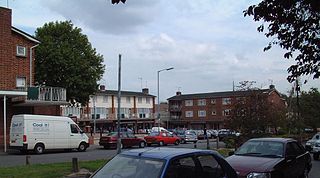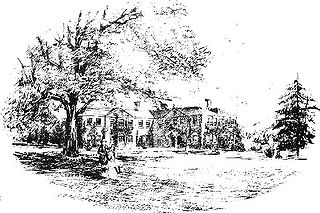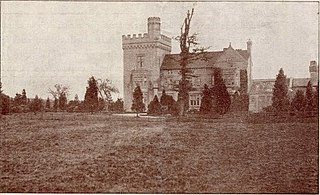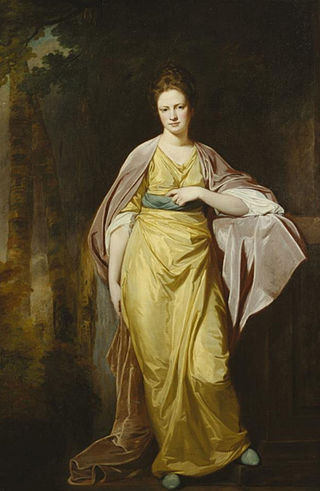Related Research Articles

Royal Leamington Spa, commonly known as Leamington Spa or simply Leamington, is a spa town and civil parish in Warwickshire, England. Originally a small village called Leamington Priors, it grew into a spa town in the 18th century following the popularisation of its water which was reputed to have medicinal qualities. In the 19th century, the town experienced one of the most rapid expansions in England. It is named after the River Leam, which flows through the town.

Southam is a market town and civil parish in the Stratford-on-Avon district of Warwickshire, England. Southam is situated on the River Stowe, which flows from Napton-on-the-Hill and joins Warwickshire's River Itchen at Stoneythorpe, just outside the town.

Warwick is a market town, civil parish and the county town of Warwickshire in the Warwick District in England, adjacent to the River Avon. It is 9 miles (14 km) south of Coventry, and 19 miles (31 km) south-east of Birmingham. It is adjoined with Leamington Spa and Whitnash.

Warwickshire is a ceremonial county in the West Midlands of England. It is bordered by Staffordshire and Leicestershire to the north, Northamptonshire to the east, Oxfordshire and Gloucestershire to the south, and Worcestershire and the West Midlands county to the west. The largest settlement is Nuneaton, and the county town is Warwick.

Leek Wootton is a village and former civil parish, now in the parish of Leek Wootton and Guy's Cliffe, in the Warwick district, in the county of Warwickshire, England, approximately 2 miles south of Kenilworth and 2.5 miles north of Warwick. It lies in the triangle created by Kenilworth, Warwick and Leamington Spa. In 1961 the parish had a population of 671.
Radford Semele is a village and civil parish in Warwickshire, England, situated close to the Regency spa town of Leamington Spa. According to the 2001 Census, Radford Semele parish has a population of 2,448, according to 2021 census. It lies on the A425 between Leamington and Southam. It has a 16th-century pub with a priest hole. The local school is the Radford Semele Church of England School. This is a primary school and most senior pupils go to school in either Southam, Leamington Spa or Warwick which are close by. As well as the parish church of St Nicholas the village also has a second church built in 1874, the Radford Semele Baptist Church.

Lillington is a suburb of Leamington Spa, in the civil parish of Royal Leamington Spa, in the Warwick District in the county of Warwickshire, England. Historically a village which existed before the time of the Domesday Book (1086), it was incorporated into the borough of Leamington in 1890. Lillington is a ward of Warwick District Council and Royal Leamington Spa Town Council.

Trinity Catholic School is a mixed Catholic secondary school and sixth form located in Leamington Spa, Warwickshire, England.

Leamington Hastings is a small village and larger civil parish in Warwickshire, England. The civil parish covers Leamington Hastings itself, plus the nearby hamlets of Broadwell, Hill and Kites Hardwick. Its population in the 2011 census was 440, increasing slightly to 466 at the 2021 census.

Cubbington is a village and civil parish with a population of 3,929, adjoining the north-eastern outskirts of Leamington Spa, Warwickshire, England, approximately 3 miles from the town centre. Welsh Road, running through the village crossroads, was an old sheep drovers' route connecting London and Wales. Since the 1950s when the village expanded there have been two parts to the village: Cubbington proper which was the old village core, and New Cubbington which is to the west, although both are referred to as Cubbington. Topographically the highest point of the village sits about 100 metres (330 ft) above sea level while its lowest is about 60 metres (200 ft). For many years the electorate for Cubbington was represented in government by the MP for Warwick and Leamington but for the 2010 UK Elections it moved to the new Kenilworth & Southam constituency.

Stivichall or Styvechale is a suburb of the city of Coventry, West Midlands, England. It is a mainly residential area in the south of the city.

Thornbridge Hall is a large English country house situated near the village of Great Longstone in the local government district of Derbyshire Dales in Derbyshire. It is a Grade II listed building.

Alfreton Hall is a country house in Alfreton, Derbyshire. It was at the heart of local social and industrial history in the county. The history of the estate goes back to Norman times, but by the 17th century it was owned by the Morewood family, who were linked to local industry, mainly in coal mining.

Ladbrooke is an historic estate in the parish of Tanworth-in-Arden, Warwickshire, England. The early history until the late 14th century is sparse and inextricably confused with the manor and parish of Ladbroke near Southam in Warwickshire, 34 km to the south-east. The confusion arises not only because both places within the same county are spelled variously and identically in historic documents, but mainly because the mediaeval de Lodbroke family appear to have held estates in each place. The 1619 Heraldic Visitation of Warwickshire which gives the pedigree of the "de Lodbroke" family, states them as "Dominus de Lodbrooke" and makes no mention of Tanworth-in-Arden. The Victoria County History is however clear that the seat of the de Lodbroke family was Ladbroke near Southam and not Ladbrooke in the parish of Tanworth-in-Arden.
The Dallas Burston Polo Club is a 600 acre polo club based near the market town of Southam, Warwickshire. Opened in 1999, and merged with the Stoneleigh Park club in 2003, it was until 2012 named the RLS Polo Club. It boasts 6 polo grounds, an all-weather SuperArena as well as a 3,000 person capacity conference and events venue which opened in 2014. There are 15 paddocks and 26 stables for horses. There is also a bar and lounge named the Millstone Hare which is open Monday to Sunday and serves traditional pub styled food. In November 2015 it was announced that there would be a £122 million investment in the club over the next 12 years, adding a hotel, up to 100 holiday lodges and a re-vamped player's pavilion.

Valerie Domleo, also known as Valerie Domleo-Morley or Valerie Morley, was an English physicist, rally co-driver and farmer.

Ellen Morewood or Ellen Goodwin; Ellen Goodwyn; Mrs. George Morewood; Mrs. Henry Case-Morewood was an English colliery owner based at Alfreton Hall in Derbyshire. She unsuccessfully defended her right to mine under land adjacent to hers and she carried forward the Morewood name.

The Umberslade Obelisk is a Grade II listed monument in Warwickshire, England constructed by order of Thomas Archer, 1st Baron Archer, on his estate of Umberslade Hall in 1749. The obelisk is constructed from grey limestone and stands 70 ft (21 m) tall. The reason for its construction is unknown, but it may have simply been to enhance the view from the hall windows. The obelisk lies near the M40 motorway.
East Haddon Hall School was a boarding school for girls aged from eleven to seventeen at East Haddon Hall in West Northamptonshire, England. In 1967 it moved to Ladbroke Hall and took that name, before closing in 1971.
References
- 1 2 A History of the County of Warwick Vol 6 (1951), pp. 143–147, British History Online
- ↑ Historic England. "Ladbroke Hall (1185629)". National Heritage List for England . Retrieved 15 October 2019.
- ↑ Dod's Parliamentary Companion (1966), p. 230: "Address, The Lord Rootes, Ladbroke Hall, Ladbroke, nr. Leamington Spa"
- ↑ "New private school for girls: former home of Lord Rootes", Coventry Evening Telegraph , 19 May 1967, p. 55
- ↑ The Education Committees' Year Book 1970 (Association of Education Committees, 1970, p. 503: "Ladbroke Hall †, Southam, Warks (Girls') (70); Mrs E. J. Lewis, BA"
- ↑ "LADBROKE HALL, SOUTHAM", Coventry Evening Telegraph, Monday 26 July 1971, p. 31
- ↑ "Rats in a historic manor", Coventry Evening Telegraph, Saturday 7 October 1972, p. 12